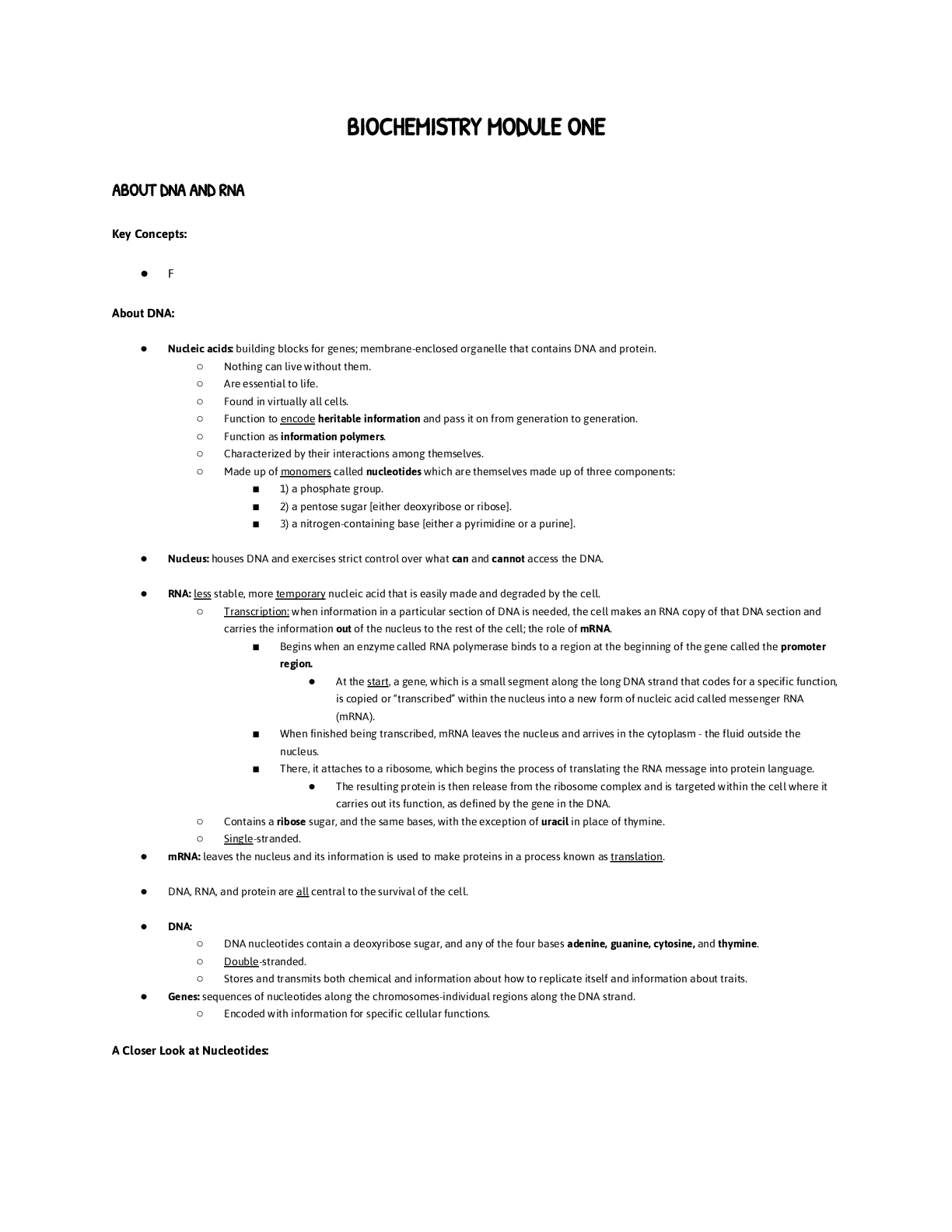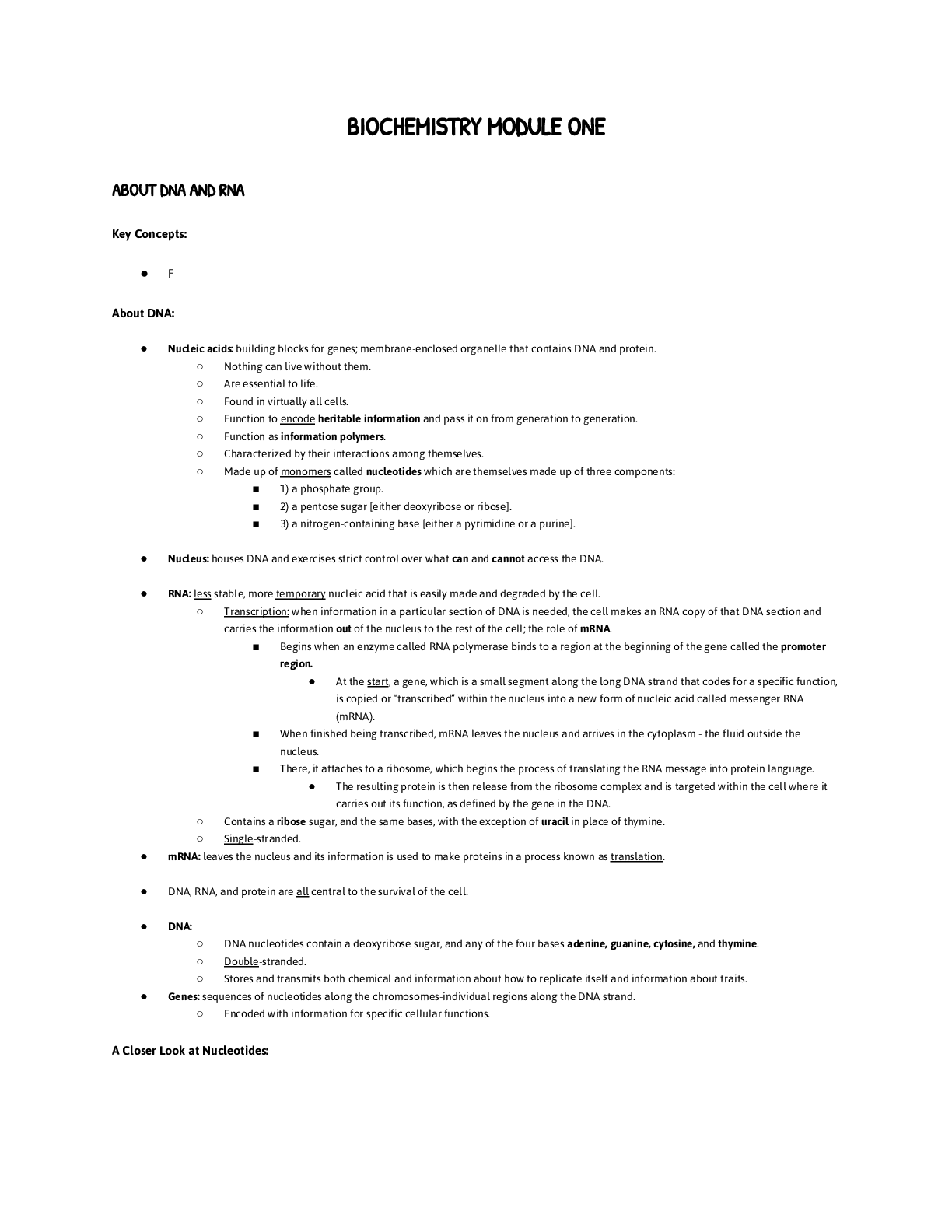ABOUT DNA AND RNA
Key Concepts:
● F
About DNA:
● Nucleic acids: building blocks for genes; membrane-enclosed organelle that contains DNA and protein. ○ Nothing can live without them. ○ Are essential to life. ○ Found in virtually all cells. ○ Function to encode heritable information and pass it on from generation to generation. ○ Function as information polymers. ○ Characterized by their interactions among themselves. ○ Made up of monomers called nucleotides which are themselves made up of three components: ■ 1) a phosphate group. ■ 2) a pentose sugar [either deoxyribose or ribose]. ■ 3) a nitrogen-containing base [either a pyrimidine or a purine]. ● Nucleus: houses DNA and exercises strict control over what can and cannot access the DNA. ● RNA: less stable, more temporary nucleic acid that is easily made and degraded by the cell. ○ Transcription: when information in a particular section of DNA is needed, the cell makes an RNA copy of that DNA section and carries the information out of the nucleus to the rest of the cell; the role of mRNA. ■ Begins when an enzyme called RNA polymerase binds to a region at the beginning of the gene called the promoter region.● At the start, a gene, which is a small segment along the long DNA strand that codes for a specific function, is copied or “transcribed” within the nucleus into a new form of nucleic acid called messenger RNA (mRNA). ■ When finished being transcribed, mRNA leaves the nucleus and arrives in the cytoplasm - the fluid outside the nucleus. ■ There, it attaches to a ribosome, which begins the process of translating the RNA message into protein language. ● The resulting protein is then release from the ribosome complex and is targeted within the cell where it carries out its function, as defined by the gene in the DNA. ○ Contains a ribose sugar, and the same bases, with the exception of uracil in place of thymine. ○ Single-stranded. ● mRNA: leaves the nucleus and its information is used to make proteins in a process known as translation. ● DNA, RNA, and protein are all central to the survival of the cell. ● DNA: ○ DNA nucleotides contain a deoxyribose sugar, and any of the four bases adenine, guanine, cytosine, and thymine. ○ Double-stranded. ○ Stores and transmits both chemical and information about how to replicate itself and information about traits. ● Genes: sequences of nucleotides along the chromosomes-individual regions along the DNA strand. ○ Encoded with information for specific cellular functions.
A Closer Look at Nucleotides:
● Nucleotides: ○ Are linked together by a phosphodiester bond between the phosphate of one nucleotide and the sugar of another. ○ Consecutively linked by a phosphodiester bonds form a polymer in which the bases project out from a backbone of repeating sugar-phosphate groups. ■ This phosphodiester bond creates the sugar-phosphate “backbone” of DNA. ○ Structure: ■ Each has a nitrogenous base, a pentose sugar, and a phosphate. ■ When attached together, the polymer also has a 5’ (“five prime”) and a 3’ (“three prime”) end. ■ Nucleic acids are always made in the 5’ -> 3’ direction, which means the 5’ end represents the beginning of a nucleic acid strand and nucleotides are added to the 3’ end. ■ Directionality is like a LEGO brick, which has a bumpy side and a side with holes when it is a single brick (monomer) or when several bricks are in a stack (polymer). ■ The same DNA strand can be shown in different directions. DNA strands are often written in the 5’ to 3’ direction (as shown above left), but the same exact DNA molecule can also be written with its 3’ end on the left (as shown above right). Turning it doesn’t change the identity of the molecule.
DNA is a Double Helix:
● How Bases Pair Together in DNA:
○ The sugar-phosphate backbones of the two strands of DNA are separated by a constant distance, regardless of whether the base pair is A:T, G:C, T:A, or C:G. ■ This constant distance for correct base pairs is often illustrated by showing the DNA in a ladder-like structure (below, left) with the two sugar-phosphate backbones as the vertical supports and the base pairs as the rungs. ■ However, in reality, the two strands of DNA twist around each other to generate the familiar double helix (below, right)
Read More


